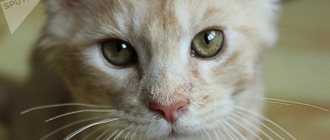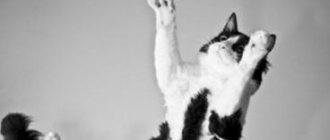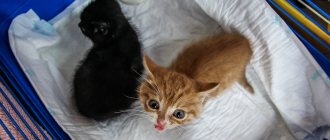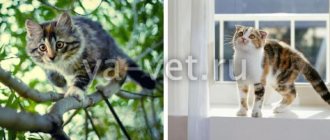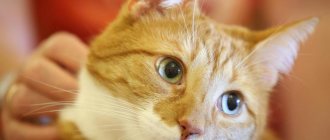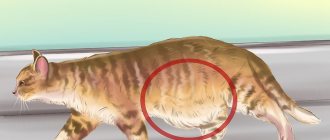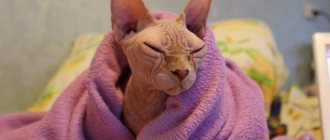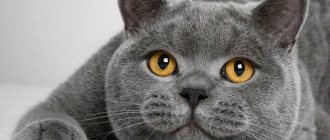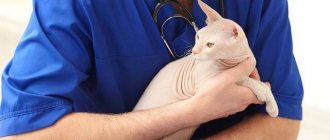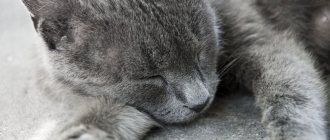Every cat owner considers his own pet to be the best, most beautiful and unique. The owner of a purebred kitten has reason to be proud of his aristocratic origins and corresponding pedigree.
Those who have an ordinary mongrel dog slumbering at their side can only be consoled by its devotion and wonderful character. However, the owner has the opportunity to classify his mustachioed cat independently as a breed.
It can be determined by the appearance of the animal. The dimensions of a cat, the size of its ears, the length of its paws and tail, as well as the texture and color of its fur can tell a lot to an inquisitive observer.
A table that will help you determine the cat breed
| Breed | Photo |
| American (including those that appeared or were bred in the USA) | |
| American Wirehair | |
| American Shorthair | |
| American Curl | |
| American Ringtail | |
| Bombay | |
| York chocolate | |
| Maine Coon | |
| Ojos Azules | |
| Ragamuffin (from Ragdolls) | |
| Ragdoll | |
| Asian | |
| Asian tabby | |
| Asian Tiffany | |
| British and Scottish | |
| British Longhair | |
| British Shorthair | |
| British chinchilla | |
| Scottish Fold (Scottish Fold) | |
| Scottish Straight (Scottish Straight) | |
| Scottish Fold Longhair (Highland Fold) | |
| Bobtails (no tail or short) | |
| American Bobtail | |
| Karelian Bobtail | |
| Kymri (Kymrik, semi-long-haired species of Manx) | |
| Kurilian Bobtail | |
| Mekong Bobtail | |
| Manx (Manx) | |
| Pixiebob | |
| Skif tai dong | |
| Japanese Bobtail | |
| Hybrids | |
| Bengal (from Asian leopard cat) | |
| Bristol (from the wild long-tailed cat Margay, they were similar to Bengals, but now breeding work has stopped, there are no more cats) | |
| Karaket (from Karakal) | |
| Savannah (asherah) (from Serval) | |
| Safari (from Geoffroy) | |
| Serengeti (from Bengal cat) | |
| Toyger (breeding work with Bengal) | |
| Chausie (from Jungle Cat) | |
| Naked | |
| Bambino | |
| Dwelf (from Munchkin, Sphinx and Curl) | |
| Don Sphynx | |
| Canadian Sphynx | |
| Minskin (from Munchkin and Sphinx) | |
| Petersburg Sphinx (Peterbald) | |
| Ukrainian Levkoy | |
| Elf (from the Canadian Sphynx and Curl) | |
| With Siamese point color | |
| Balinese or Balinese (Balinese) | |
| Burmese | |
| Himalayan (similar to Persian, long-haired) | |
| Neva Masquerade | |
| Siamese | |
| Snow-shoe | |
| Thai | |
| Tonkinese (hybrid of Thai and Burmese) | |
| Short-legged | |
| Munchkin | |
| With blue color | |
| Korat | |
| Nibelung | |
| Russian blue | |
| Rex (with curly hair) | |
| Devon Rex | |
| Hermann rex | |
| Cornish Rex | |
| Laperm | |
| Selkirk Rex | |
| Ural rex | |
| Flat faced Persian | |
| Napoleon (minuet) | |
| Persian | |
| Exotic Shorthair | |
| Oriental view | |
| Javanese | |
| Oriental | |
| Foreign White | |
| Other shorthairs | |
| Abyssinian cat | |
| Australian Mist (Australian Smoke) | |
| Anatolian cat | |
| Arabian Mau | |
| Brazilian | |
| Burmanskaya | |
| Burmilla (a hybrid of Burmese and Persian) | |
| Havana | |
| European Shorthair | |
| Egyptian Mau | |
| Kanaani | |
| Khao-mani | |
| Carthusian (Chartreuse) | |
| Lykoi | |
| Ocicat | |
| Sokoke | |
| Aegean | |
| Other longhairs and semi-longhairs | |
| Norwegian forest | |
| Siberian | |
| Somali (from Abyssinian) | |
| Turkish Angora | |
| Turkish van | |
size table
Manufacturers conventionally divide all cat breeds into large, medium and small (L, M, S), and then make a breakdown in increments of 3-5 cm, referring to the control measurement of neck girth. Before purchasing, it is worth checking whether the table includes allowances for loose fitting - after all, the cat does not need tight-fitting clothes.
A couple of cm are added to the measured home values for freedom of movement of the animal, then the size is determined from the table.
Important: the choice of size also depends on the type of fabric. If the control measurements with an increase were obtained on the border of two sizes, choose the smaller one when the fabric stretches well (for example, knitted fabric, lycra, jeans with elastane).
If the table determines the size of the cat, and the planned purchase is a jumpsuit worn on four paws, additionally measure their girth.
Before paying for clothes in a pet store, ask the seller about the elasticity of the materials, if necessary, add a couple of centimeters for movement.
Methods for determining cat breed
Here are the main points that will help determine the breed if the table above does not cope with this:
- Mutation signs and features. More often it is the shape and size of the ears - for example, curled back in Curls or drooping in Scottish Folds. Tassels on the tips are also a characteristic feature (Caracat, Maine Coon). The short length of Munchkin's limbs, fixed by a mutation gene, also makes him easily recognizable.
- The color of the iris, their shape and location. Some lines have only one eye color (blue - Siamese, green - Nibelungs) or multi-colored, like the Turkish Van. Asian cats, in addition, have a characteristic oriental cut, often with a slight braid.
- Head shape and coat color. There are varieties that you will never confuse with anyone else due to the peculiar structure of the skull. For example, in Oriental it is narrow and elongated, while in Exot it is almost rectangular with rounded edges and an original flattened nose. The wild spotted color of the Bengal differs significantly from the pattern of the color-point Siamese.
- Body type and coat quality. Bengals, Toygers, and some other breeds are characterized by a strong, muscular and agile body. Orientals, Thais and Sphinxes have an elegant, sophisticated physique. American Shorthair, bobtails are stocky, powerful, and heavy in appearance. The type of coat differs significantly between longhaired, semi-longhaired, short-haired and hairless cats.
- The animal's temperament is also a feature of the breed. On this basis, the lively and restless Abyssinians can never be confused with the phlegmatic Briton.
How to take measurements
When a cat sits or lies, the spine changes length due to deflection or twisting. Clothing for a cat is designed for movement, so measurements are taken after placing the animal.
It is better to measure together. The owner calls the cat, holding a treat in his palm. The palm of the other hand gently supports the stomach, preventing the animal from sitting down.
At this time, the assistant measures:
- the length of the back from the withers to the beginning of the tail (not the end of the body);
- neck circumference (the tape is placed in the middle);
- chest volume (widest point);
- volume of the abdomen (when the cat is expecting kittens, or the pet is well-fed).
Common clothing models are blouses with an elongated back or blankets with a hole for paws without sleeves. When you plan to purchase items with sleeves and legs, the circumference (volume) of the paws is measured.
- The cat stands on four legs, head slightly raised (standard stance).
- The tape wraps around the front legs at chest level just behind the limbs.
- To measure the hind legs, the tape is run parallel to the floor from the level of the groin towards the tail.
- If trousers are purchased, measure the length of the leg from the root of the tail to the desired length (usually the hock).
Why determine the breed and when is it necessary?
It may be necessary to determine the breed of a cat if:
- The pet was purchased from unknown persons, without documents, and it must be registered at a veterinary clinic or felinological club.
- Mating with a purebred male (female) is planned.
- A cat found on the street or abandoned needs to be given an accurate diagnosis, which may be related to hereditary or specific diseases.
- A pet is beautiful and unusual and many people want to have the same one, or a photo with a cat has made them want to have an animal of this type.
To register a furry friend in the association of felinologists, it is necessary to have a pedigree or birth certificate - birth documents that indicate both parents with their document numbers and titles.
Javanese Burma
Both must be certified by a seal and contain information about the club and nursery. Even if an animal is born from a titled pair of the most expensive cats, without official paper it will be considered outbred.
In order to spend less money when purchasing an animal, many people buy it as a pet-class pet, that is, as a pet, since the price in this case is significantly lower. After which, by any means, even turning to scammers, they try to make a pedigree. This is a big mistake. All purebred individuals are registered in the electronic felinological database. The deception will definitely be revealed and the animal will be disqualified.
If the owner plans to engage in breeding or participate in exhibitions with the cat, you should not save when purchasing.
Breed class (animal for breeding) and show class (exhibition) do not have the right to be outbred. Therefore, if a furry pet with a pedigree is offered a mating with an animal, even clearly an “aristocrat”, but without documents, you should refuse. Otherwise, you need to understand that the offspring born will not be considered purebred.
In the veterinary passport, the name of the breed is quite arbitrary; the entry is made there according to the words of the owner and cannot be a document confirming the origin of the individual.
If a cat is found on the street, then, first of all, it should be taken to a veterinarian to identify diseases and undergo vaccination.
It is not worth using such an individual to produce offspring, even if the tramp looks like, for example, a handsome Bengal. It is unlikely that a purebred animal will end up on the street. And it’s impossible to make a pedigree for him.
Ocicat Snow Shoe
Siberian cat
But if your pet has obvious health problems, then it is advisable to find out whether it belongs to a certain type. Some feline “aristocrats” are characterized by characteristic diseases. Diagnosis can be greatly simplified.
It is possible to determine the breed from a digitized photograph by doing a “picture search” on the Internet. Or if there are characteristic features - a short tail, characteristic ears, fur and color - formulate a description task in a search engine.
The best method is to contact a felinologist, for example, by visiting a cat show.
Pedigree and mongrelism
Before determining the breed, most often you have to find out whether the cat belongs to any breed at all or is outbred. To find out, you need to answer the following questions:
- Is the color of the animal atypical, somehow different from most of its fellows?
- How are the ears, limbs, tail developed, are there any non-standard differences?
- Is the cat's size larger or smaller than most of its fellows?
- Are there any peculiarities in the structure of the coat, such as small curls, waviness, long hair, etc.
- Are there any other features in the animal’s appearance?
If you can give a positive answer to at least one question, you should assume that the cat is purebred.
The main differences between purebred and outbred pets based on various factors
Any cat is unique and inimitable, regardless of whether it has a purebred document or not. But there are still some differences.
Each breed officially registered in the felinological system has a standard - a detailed description of its appearance: size, proportions of the body and limbs, color and length of coat, eye shape, ear position and other data. Even the standard character of an individual is usually described there.
Photos will be provided, from which it is quite easy to determine whether the pet belongs to this line.
The most characteristic colors for some varieties:
- A kind of “mask” on the face, paws and tail of the same color, darker than the main tone - Siamese, Neva Masquerade, Thai breeds.
- Blue coat color with a silver haze - Russian Blue or Nibelung.
- Color with a “leopard” spot or “rosette” - Bengal, Savannah, Ocicat, some other lines with a “tabby” color.
- Ticked reddish coat in the Abyssinian and Somali.
- Toyger has brindle coloring - pronounced black stripes on short fur.
- All varieties of Rex have wavy or curly fur.
- The paws end in white “socks” in the Snowshoe or Sacred Burma.
Maine Coon Wild Caracal with tassels
Manx without a tail
You can also determine the pet's identity based on the type of fur:
- All Sphinxes have no fur at all: Canadian, Don, St. Petersburg.
- The coat of the Cornish Rex and Devon Rex is short and wavy.
- Selikt rexes have long and curly hair.
- Short and stiff, but at the same time having ringlets, the coat belongs to the American Wirehair or Curly Hair cat.
- Long, thick and fluff-like fur is characteristic of the Persian cat and the Turkish Angora.
British chinchilla
Sphinxes
Persian cat
According to anatomical features:
- Tassels on the ears - Maine Coon, Pixie Bob, Caracat, Siberian cat.
- The tips of the soft ears “hanging” forward are found in Scottish Folds.
- Curled ears make any Curl recognizable.
- Bright blue or blue eyes - in Siamese cats, Mekong Bobtail, Sacred Burma, Turkish Angora, Ragdoll, Javanese.
- Nibelung and Russian Blue have emerald eyes.
- Multi-colored eyes (such as blue-green or blue-yellow) are often found in the Khao Mani, Turkish Angora, and Turkish Van.
- Tailless cats - Kurilian, American bobtail, Pixie-Bob.
- The Mekong Bobtail has a short tail with kinks and bends.
- The tail is wrapped in a ring, like a Siberian husky, only in one breed - the Ringtail or Ring-tailed cat.
- Short legs - Munchkin.
- Siamese and Oriental cats have an elongated, rather narrow muzzle and large ears.
- Very large, but at the same time graceful, short-haired and similar to a wild cat - Savannah, Caracat, Chausie.
- Large, massive, heavy in appearance, with long hair - Maine Coon, Siberian, Norwegian Forest.
Norwegian Forest Cat
Balinese cat
Japanese Bobtail
Munchkin
Oriental
Does your cat have external differences from ordinary cats?
How to recognize a cat's breed by external features?
Most outbred cats correspond to one gold standard: medium-sized paws, medium-wide chest and rump, and a rounded head, crowning this standard splendor.
But we're talking about exceptions, right? So, what exceptional external characteristics bring a simple cat closer to a purebred cat?
Ears
- American Curl. These are the only cats in the world whose ears are folded back. The bend can reach 180 degrees.
- Ukrainian Levkoy. A hairless or slightly fluffy Levkoy is different... Yes, in fact, this breed is different from everyone else. You can recognize it by its ears, which are literally curled up in Levkoys.
- Scottish lop-eared. Sometimes it seems that Scots don’t have ears, but in fact the problem is in the cartilage, which is so deformed that the pinna seems folded in half. The degree of bending varies from barely noticeable to almost complete fit to the head.
- Elf Kat. Americans Karen Nelson and Kristen Leedom bred a breed with wonderful ears. Indeed, it is impossible not to notice a cat with such huge patterned ears.
- The poodlecat is an exotic and artificially bred breed. Fold-eared representatives of the breed have ears that do not lie close to the head, and it is believed that the more beautiful the poodle cat is, the larger its floppy ears.
Short tail
Cats whose tail is in its infancy (or even none at all) are worth a lot. Unlike artificial docking in dogs, a cat's short tail is a purebred sign:
- Cymrik is a breed without a tail at all. From the word absolutely. At the same time, Cymrics have short front legs and a peculiar jumping gait.
- Manx are another tailless purr. True, not all of them - according to the standard, Manxes either have no tail at all or show off with a very long one.
- Pixiebob is a mini-lynx that was bred in the 80s of the 20th century. The tail of domestic predators can sometimes be two centimeters long, and sometimes even 15 cm.
- The Kurilian Bobtail is a breed in which the genes of the Japanese Bobtail and Siberian cat are mixed, bred in Russia.
- The American Bobtail demonstrates its temperament with its tail, which reaches the base of its hind legs.
- The Japanese Bobtail is a classic representative of cats with short tails. According to the standard, the tail of a Japanese bobtail should, firstly, be no longer than 12 centimeters, and secondly, the tail must be curled.
Little paws
When breeders began to breed cat breeds with short legs one after another, fears arose that in the future such pussies would have problems with mobility or the spine. But time has shown that these suspicions are unfounded, since short legs are compensated by greater flexibility of the spine.
Are your cat's paws significantly shorter than your neighbor's paws? There are several breeds for you to choose from, most of which you have already met above.
- Skookum - the dwarf La Perm has a long and wavy coat. Another feature of the breed is its pronounced collar. By the way, the breed was originally called poco chino (Small Curly).
- Dwelf - without hair, without long legs.
- Munchkin
- Napoleon
- Minskin
- Bambino
Breed classification
Felinology is a science that studies the anatomy and physiology of cats, their reproduction and selection. There are many systems for recording and assessing animals in this area. For the most part, they come down to two groups - American and European.
At cat shows, without exception, everyone is judged by genotype. Family affiliation and origin are determined by the pedigree - the main cat document, which, in fact, reflects the family tree of the pet, at least up to the fourth generation. In addition to the names of the ancestors, all colors and dates of birth, the names of the nurseries where the animals came from are indicated.
The data of the club and the association itself are necessarily recorded in the “header” of the document.
Each pedigree has its own number, by which it can be easily found in the electronic accounting system. Colors are designated by specially adopted codes.
Such a document not only indicates the pet’s ancestral affiliation, but also allows you to determine which genes it is a carrier of, and what kittens it may have.
Only the oldest American system, TICA, as the most democratic, allows assessment by phenotype - the appearance of the animal.
In this system, all individuals are divided into six categories:
- Category I - Established Breeds - lines formed as a result of selection.
- Category II - Natural Breeds - natural breeds.
- Category III Variant or Mutation Breeds - the result of genetic mutations.
- Category IV - Domestic Hybrid Breeds - interbreeding.
- Category V - Non-Domestics Source Breed Hybrids - crossing of domestic and wild animals.
- Category VI - Experimental Breeds - experimental breeds.
The cat's status code is indicated by a set of Latin letters and numbers (date of birth and personal number).
If the alphabetic code SB is written in the pedigree, such a pet is a full-fledged representative of one of the recognized breeds. Its designation and the name of the animal (usually includes the nursery's own name) are written in the first line.
There are four categories in the European WCF system. Cats are divided according to the type of cover:
- Category I - Shorthair I - animals with short hair, group 1 - includes Orientals, Siamese and Thais, Peterbald and Tonkinese cats.
- Category II - Shorthair II - animals with short hair, group 2 - all other shorthaired animals.
- III category - Semi-Longhair - semi-longhaired cats - Siberian, Maine Coons, Norwegian Forest, Nibelung, others.
- Category IV - Longhair - long-haired group - Persian only.
In this system, the pedigree number encrypts: breed, category, color and sex of the animal. A cat from the experimental group or an unrecognized variety will not be issued a document in this system.
Pedigrees of other systems are not very common in Russia. But if you need to decrypt them, you should contact the club that issued it.
Information about him and the feline system, indicating telephone numbers and addresses, is required in the document of any association.
Singapore
Siberian cat
Sphynx cat clothing sizes
We make clothes for cats from elastic fabrics that stretch well. This should be taken into account if you find it difficult to determine the size you need. We advise you to order clothes for your pets that are looser, so that they do not feel constrained and they feel comfortable in it. However, we must remember that your cat will quickly get rid of clothes that are too loose, especially if she is not accustomed to wearing them. Dimensions are indicated in centimeters.
Dear customers of our store!
Please note that before ordering clothes or shoes for your pet, take your pet’s measurements and double-check them several times. The comfort of your four-legged friend depends on this!
Clothes for dogs and cats, as a rule, are not tied to the breed of your pet, just like with people. They do not purchase clothes of a wide variety of nationalities, with the exception of national outfits. The measurements for dogs and cats are also very similar! Refer to manufacturers' size tables - the size range of different manufacturers may differ significantly (on our website they are given to the same standard, in accordance with the table below)! To determine the correct size, you need to know the measurements of three parameters: back length, chest circumference, neck circumference.
| Size | Neck circumference | Back length | Bust |
| 3XS | 10 cm. | 15 cm. | 17-25 cm. |
| 2XS | 13 cm. | 17 cm. | 22-30 cm. |
| XS | 15-18 cm. | 20 cm. | 27-35 cm. |
| S | 18-23 cm. | 25 cm. | 32-40 cm. |
| M | 23-28 cm. | 30 cm. | 37-45 cm. |
| L | 28-33 cm. | 35 cm. | 42-50 cm. |
| XL | 33-38 cm. | 40 cm. | 47-55 cm. |
| 2XL | 38-43 cm. | 45 cm. | 52-60 cm. |
| 3XL | 43-48 cm. | 50 cm. | 57-65 cm. |
Mr. Cat recommends: Online locator
Today, in the age of the ubiquitous Internet, to determine or clarify the breed of a pet, you can turn to “online identifiers”.
These virtual assistants are tables that systematize the breed characteristics of a wide variety of cat representatives. Simply by answering the questions posed using logical chains, you can determine whether the animal is purebred and which group it belongs to.
It should be remembered that these determiners are not an official expert; according to their estimates, it is impossible to obtain a pedigree for a cat. They cannot give a 100% guarantee that the result will be correct.
In this case, it is advisable to evaluate an adult animal; it is impossible to test a newborn here. The kitten needs to mature for at least six months in order for its breed characteristics to appear.
How are different types of harnesses worn?
Methods for putting a harness on a cat depend on the type of device. In order not to get confused in the loops of the structure, you should focus on the ring for the leash - in all models of harnesses it is placed on the animal’s back, between the shoulder blades.
For the G8 model, the procedure is as follows:
- Place the cat's head through the smaller loop.
- Insert the cat's front paws into the large loop.
- Fasten the harness.
For the Y-model the order is the same. The main thing is to make sure that the jumper that connects the straps is located between the pet’s paws.
The V-model (without collar) is even easier and faster to put on - you only need:
- Lay the structure out on a flat surface.
- Place the cat's front paws in the appropriate loops.
- Raise the harness and secure it to the animal using the clasp on the back.
To put on the H-model, all you need to do is:
- Place the cat's head through the small loop.
- If there is an additional bridge on the chest, then thread the pet’s paws into the corresponding parts of the harness so that the bar is between them.
- Secure the large loop strap with a clasp at the back.
All loops must be adjusted to fit the size of the animal. A finger should fit freely between the harness straps and the pet’s body.
As for “vests” and “overalls”, they are divided into 2 types - with fasteners at the top (on the back) and at the bottom (on the chest and stomach).
They are put on according to a similar principle:
- Place the whole part on the animal (from below or from above - depending on the type of model).
- Place the paws into the holes.
- Fasten the structure.
The leash is attached to the attached harness.
Features of pedigree kittens
Determining the breed of a kitten by phenotype is not always within the power of a professional. Some have such obvious natural features that they cannot be confused with anyone else; in this case, the table at the beginning of the article will help. Others differ so little from each other that they require the help of an experienced felinologist, supported by a genetic test.
Selkirk Rex
Balinese
Signs of thoroughbredness and obtaining a pedigree are important for those cases when the pet is awaiting breeding work or an exhibition career.
It must be remembered that the upbringing, love and appreciation of a cat is not determined by the “purity” of its blood.
How can you tell if a kitten is purebred or not?
Felinology is a science that studies the characteristics and behavior of domestic cats. This industry employs professionals who can determine the breed of a kitten. All the main features are recorded in the registration books. If your furry friend meets certain standards, he is classified as one or another breed.
A purebred cat is awarded a special document that contains his entire pedigree, the characteristics of the purr breed, and even the names of two or three of his ancestors. Yes, yes, everything is so serious.

